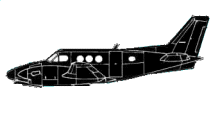
ASN Wikibase Occurrence # 200338
This information is added by users of ASN. Neither ASN nor the Flight Safety Foundation are responsible for the completeness or correctness of this information.
If you feel this information is incomplete or incorrect, you can submit corrected information.
| Date: | Sunday 26 June 2016 |
| Time: | 14:00 |
| Type: |  Beechcraft E90 King Air |
| Owner/operator: | Mile Hi Skydiving Center, Inc |
| Registration: | N92DV |
| MSN: | LW-292 |
| Year of manufacture: | 1978 |
| Total airframe hrs: | 15829 hours |
| Engine model: | Pratt & Whitney PT6-28 |
| Fatalities: | Fatalities: 0 / Occupants: 16 |
| Aircraft damage: | Substantial |
| Category: | Accident |
| Location: | Longmont, CO -
 United States of America United States of America
|
| Phase: | Manoeuvring (airshow, firefighting, ag.ops.) |
| Nature: | Parachuting |
| Departure airport: | Longmont, CO (LMO) |
| Longmont, CO (LMO) | |
| Investigating agency: | NTSB |
| Confidence Rating: |
The commercial pilot was conducting a skydiving flight with 15 skydivers on board. The pilot reported that, at 5,000 ft above ground level, he reconfigured the airplane for a climb and activated the interior amber jump lights, which indicated that the door could be opened to spot the jump zone. Two jumpers safely exited the airplane at that time. The pilot then initiated another climb. The pilot did not recall any jump indication lights being illuminated in the cabin during the climb, and none of the remaining jumpers notified him of any illuminated jump lights. However, three of the jumpers later reported that the amber jump light remained illuminated at that time. One of the jumpers informed a senior jumper from the operator that the light was on, but he indicated that it was not a problem, and the jumpers all affirmed that no one informed the pilot that the amber light remained on.
The three jumpers reported that, before reaching the jump location, when the pilot was in the process of configuring the airplane for the jump, the jump indication lights changed from amber to green, which is intended to indicate that it is safe to jump and prompted the jumpers to climb out of the airplane; however, the airplane was not correctly configured or at the proper airspeed for the jump. The three jumpers noted that the airspeed seemed faster than normal because they had difficulty holding onto the airplane. One of the jumpers, who struggled to swing his leg normally, jumped from the airplane and then struck the horizontal stabilizer. The pilot reported that he felt the flight controls jolt and heard a “thud” sound and then switched the jump lights to red and instructed the remaining jumpers to remain in the airplane. The pilot descended and landed the airplane without further incident. The jumper who struck the stabilizer was unable to move his arms and descended with his back to the ground until his automatic activation device deployed his parachute. He was subsequently transported to the hospital with serious injuries.
The accident is consistent with the pilot not reconfiguring the jump light system properly following the first jump and unintentionally turning on the green jump light before the airplane was configured properly or at the proper airspeed for a safe jump and not recognizing that he had done so. Additionally, the senior jumper did not tell the pilot that the amber light remained on after the first jump, and the jumpers improperly decided to exit the airplane even though they recognized the airplane was at a higher-than-normal airspeed.
Probable Cause: The pilot's unintentional activation of the green jump light before the airplane was properly configured and slowed for a jump and the jumpers' improper decision to continue with the jump after they recognized that the airplane was at a higher-than-normal airspeed. Contributing to the accident were the pilot’s failure to recognize that the amber light remained on after the first jump and the senior jumper's decision not to inform the pilot that the amber light remained on following the first jump.
Accident investigation:
 |
|
Sources:
NTSB
Location
Revision history:
| Date/time | Contributor | Updates |
|---|---|---|
| 11-Oct-2017 07:36 | ASN Update Bot | Added |
Corrections or additions? ... Edit this accident description
The Aviation Safety Network is an exclusive service provided by:


 ©2024 Flight Safety Foundation
©2024 Flight Safety Foundation